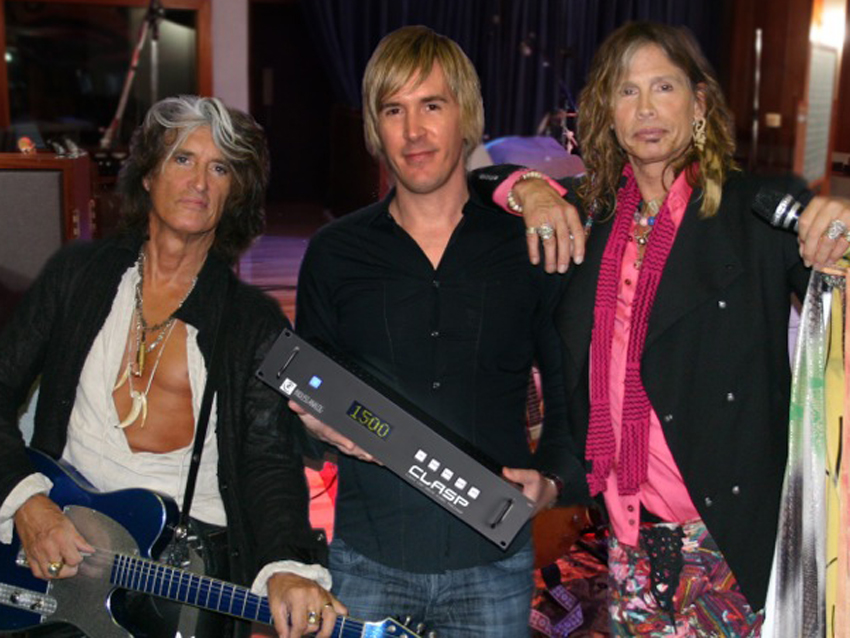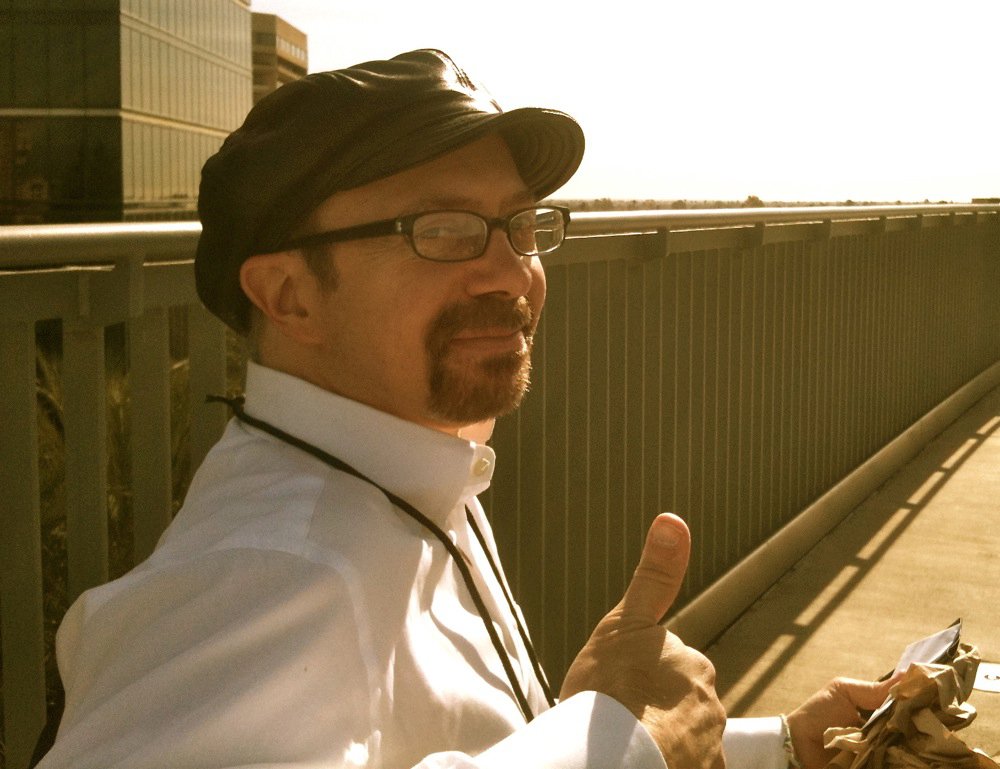

CLASP inventor and founder/president of Endless Analog, Chris Estes.
"We've gone from my workbench to the biggest and best studios in the world," says CLASP inventor Chris Estes, who's also the founder and president of a company called Endless Analog. "Everyone from Lenny Kravitz to KISS to Aerosmith is using it. People who want true warmth on their records find that CLASP really works."
So what is CLASP? Well, it stands for Closed Loop Analog Signal Processor, and it's finding its way inside such venerated studio as Abbey Road. In basic terms, CLASP is a unit and a system that integrates real analog tape recording into your DAW signal and workflow.
"I fully understand that digital recording is here to stay," says Estes. "But that doesn't mean you have to settle for a harsh, sterile sound. It's been my mission to preserve the warmth of analog recordings, and CLASP has really proved to be the answer."
Estes is back home in Nashville after from spending some time at Pandora's Box, Aerosmith's Massachusetts studio, hanging out with the band and producer Jack Douglas. CLASP is already proving invaluable to the sessions. "Aerosmith have made some of the classic rock 'n' roll records," says Estes. "They know the difference between tape and digital, and why one really sounds better. There's nothing wrong with the speed and convenience of digital, but when you sacrifice the sound, are you really advancing anything?"
How does CLASP work? What are the basic principles of the unit?
"It routes all audio signals to an analog tape medium. It does this before sending the signals back into your computer or DAW for storage and editing. What's key about this is, it does it in a way that's transparent, so that the functionality of your DAW, such as Pro Tools, is preserved.
Want all the hottest music and gear news, reviews, deals, features and more, direct to your inbox? Sign up here.
"The benefit of this is that the audio signals that have gone through the CLASP process have the warmth and depth of analog. You really can't get this sound any other way."
Can you break down exactly how CLASP works with tape mediums?
"Sure. CLASP supports a number of tape machines, everything from Studer A827s all the way back to something like a Studer J37, which is what Lenny Kravitz has in his studio. That's the recorder that The Beatles used for Sgt. Pepper.
"There's a lot of rich harmonic detail that is enhanced when you record to an analog medium. A lot of that comes from distortion. There's distortion in any recording you make, whether it's digital or analog. The difference is, the distortion on an analog recording is pleasing to the ear, whereas digital distortion isn't - it's like sandpaper to the ears.
"So recording to a piece of tape allows sounds to get rounded. They're natural and warm. People are really into software emulation these days, but it's like using artificial vanilla when baking. There's no substitute for the real thing. I should point out that digital recording was originally intended to be an editing and archival medium; it was never meant to be something that you record straight onto."
CLASP must be a budget life-saver for artists and producers who still want to use tape.
"It is. It's about $300 for a reel of two-inch 24-track tape. To make a standard album, where you'd have stacks and stacks of reels, you could easily spend $15,000 or more on tape alone. Think about it: you have to have safety copies, slave copies, you might have outtakes and alternate takes, or you might be running more than one machine for one song. Using tape has become prohibitively expensive."

"Now, with CLASP, you can use just one reel of tape to make an entire album. The way it works is, the CLASP system uses tape as a medium as opposed to a format. Because CLASP is transferring everything from the tape into Pro Tools or your DAW in real time, you don't need to keep what's on the tape - it's already being archived. It does this sample accurately. There's no delay, no waiting for the tape to sync up - it's instantaneous.
"If you remember when we met up at Lenny Kravitz's studio, Lenny has that back room where he stores a bunch of GP9 two-inch tapes. That's his favorite tape, and it's not being manufactured anymore. Up till the time he started using CLASP, he was running out of the GP9s. CLASP allows him to keep his tapes and reuse them, and he doesn't have to worry that he's erasing anything - the tape sound is real and it's all preserved. He did his new album on two reels of tape - one on each machine - instead of having stacks and stacks piling up."
Is it necessary to reconfigure software to be integrated with CLASP?
"No. The great thing about CLASP is that it's completely plug-and-play. You literally take it out of the box, plug it into your machine, and it automatically detects what's plugged into it. You don't have to do anything."
Let's go back to the beginning here. How did you come up with the idea for CLASP?
"It was out of necessity. When I was a teenager, I'd skip school with one of my friends, and we'd go to his dad's studio and cut songs. So I grew up loving the sound of tape. Fast-forward to the mid-'90s and sampling and hard disk recording had come around. I was drawn into it - I loved the ease and the capabilities. There was so much you could do with the new technology, so I went all digital for a while.
"Still, I was frustrated with the sound. I tried to convince myself otherwise, but I really missed the sound of analog. When I tried to mix something from digital, there was a thin, harsh factor that I was always fighting. I'd go back to my early recordings that were done on tape, and they sounded great. The difference between the two sounds really bothered me."

Chris Estes with a couple of Boston boys still hoping to make it big.
"So I got a Studer A827 machine, and I said, 'OK, I've got to find a way to make this work invisibly.' I sat down with a piece of paper and I sketched out a design. I showed it to my wife, Amy, and said, 'What do you think of this? Closed Loop Analog Signal Processor?' I could make this for our studio. She said, 'That looks great, but the name is too long. You should call it CLASP.'
"So I built this thing for myself. I've been tinkering with machines and programs since I was a kid. See, my dad and my uncle used to work for the Department Of Defense. My dad ran a laboratory where they used to do a lot of missile testing and development. From my dad, I learned a lot about electronics and computer programming. Writing code, building electronics, it all became second-nature to me."
After you built your first prototype of CLASP, what happened then?
"There was a lot of trial and error, but once I had my first unit, people were really into it. It worked, it sounded great, so I knew I had something that could catch on. The first producer to give me a boost was Chuck Ainlay, who's known for his work with Mark Knopfler. He was very helpful in coming up with some cosmetic design ideas.
"The first major artist to embrace CLASP was Lenny Kravitz. The unit wasn't even fully ready yet - I was showing my prototype to various companies, and they didn't know what to do with it - but I got a call from Lenny's people that he was interested it.
"Then I ended up going to AES with it in 2008. I'd become friends with a guy named Mike Spitz, who's with ATR Magnetics. They're a tape manufacturing company and kind of ran with the torch after this other company, Quantigy, went out of business. Mike was great. He let me set up CLASP in his booth and show it off, and the response was incredible.
"A few weeks later, I was back in Nashville, and I got a call from George Peterson at Mix. He said, 'Congratulations. You've just won the Mix Certified Hit Award.' My jaw hit the floor. And then I got a call from Pro Audio Review: 'Congratulations! You've just won the Par Excellence Award.' It was wild."
"Things happened very quickly after all of this. I realized my chance to strike was now. I applied for a license with Avid, even though everybody told me I was crazy, that Avid would never give me a license. But they did. They've been very helpful and gave us their blessing. So from there we got to work big-time.
"We have dealers and distributers; we're getting into studios all over the world. Abbey Road Studios is using CLASP - what a mind-blower! Then there's Blade Studios in Shreveport, Louisiana - a really amazing facility. It's a wide variety of commercial studios, but the funny thing is, it seems to be led by artists who find out about it and talk about it."
Jack Douglas has become a big fan while making the New Aerosmith record.
"That's right, Jack's really into it. He was introduced to CLASP by Warren Huart, who's engineering the new Aerosmith album. Warren is the producer and engineer for The Fray, and they use CLASP, so he told Jack about me and the unit. He was very instrumental in getting things going.
"Jack loves the sound that CLASP delivers, and you know, he made those classic records with Aerosmith back in the '70s, so this will really help maintain that huge, natural sound of the band. KISS have discovered CLASP. I was very fortunate to spend a few days with them in the studio recently. Green Day purchased a unit, so that'll be on their next record. Brendan Benson from The Raconteurs got a unit, so he's a fan now, too."
Are there any changes or tweaks you're going to be making to CLASP soon?
"The main thing is improving the integration within the Pro Tools environment. A lot of that is based on collaboration and cooperation with Avid, who've been great to us. We'll have a new software update, which will be a free download for everyone.
"We're going to have a few new products. I'm not at liberty to talk about them right now, but they're going to be very exciting. CLASP has been the unit that opened the doors for us, but it's not our only thing. We'll have more quite soon."
Joe is a freelance journalist who has, over the past few decades, interviewed hundreds of guitarists for Guitar World, Guitar Player, MusicRadar and Classic Rock. He is also a former editor of Guitar World, contributing writer for Guitar Aficionado and VP of A&R for Island Records. He’s an enthusiastic guitarist, but he’s nowhere near the likes of the people he interviews. Surprisingly, his skills are more suited to the drums. If you need a drummer for your Beatles tribute band, look him up.
